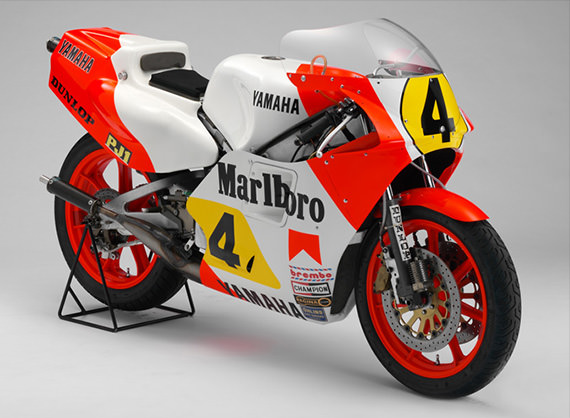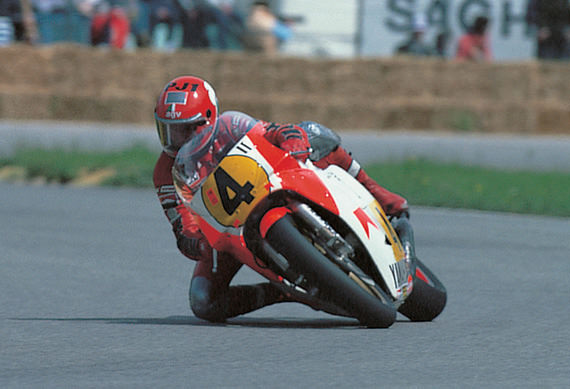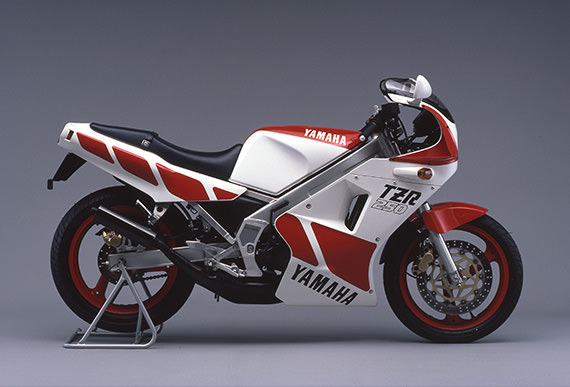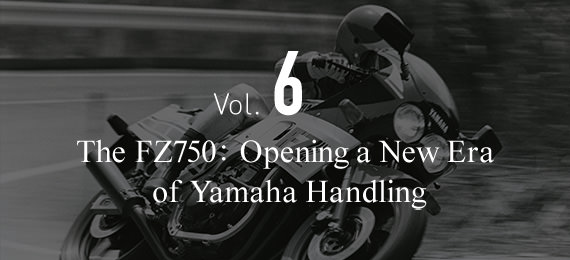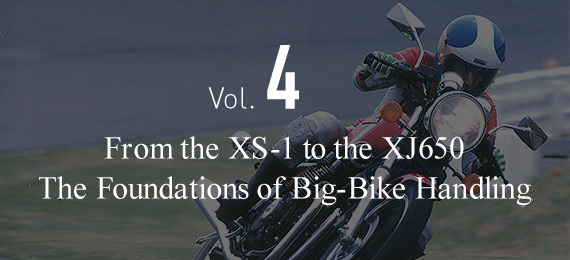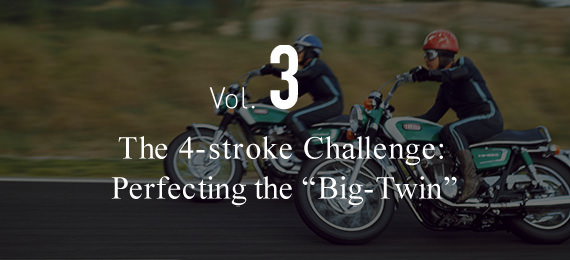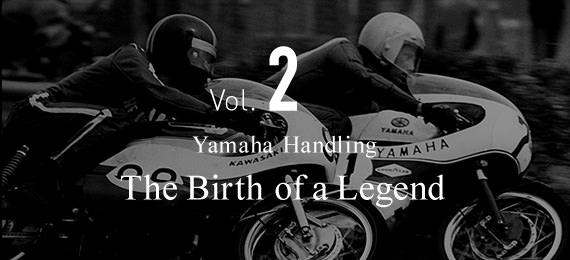A Ride Nothing Like a Race Machine
(Return to Part 1)
The 0W70 was entered in the 1983 racing season and it would power Kenny Roberts through an unforgettable season-long duel with Freddie Spencer on the Honda NS500. In his memorable last season in the World GP, Kenny’s bold, aggressive riding and the near-perfect lines he traced through the turns on the clearly well-balanced YZR500 is something many of the fans that watched him still remember vividly.
Unfortunately, he would just barely miss out on winning the title. Immediately after the season ended, I was able to get a chance to test-ride the YZR500 that he scored a victory on at the final round at Imola in Italy for a feature article in RIDERS CLUB. I will never forget how inspiring that ride was. It had a ride so different from any 750cc or 500cc class production racer or even any 500cc factory machine I’d experienced test-riding before, because it was almost like riding a regular motorcycle for the streets.
Of course, its power was certainly far from that of a regular bike and something I’d also never experienced before, and it goes without saying that all aspects of its movement had that incredibly refined quality only found on a factory machine.
But, the overall feeling of the machine was that of a regular bike.

1983 YZR500 (0W70)
This model mounted a further developed V4 engine on the Deltabox aluminum frame. In combination with its 17-inch front wheel, a new type of rear suspension and more,
it achieved outstanding handling stability
For example, when you opened the throttle during a turn, the response was sharp and immediate. But the anti-squat setting, and the relationship between the swingarm and the chassis meant that the drive force generated from the rear wheel gripping the track was one you could feel coming, but it was smooth, so it didn’t make the rider overly tense. And when you opened up the throttle in the mid-range, the engine had a character that made the power delivery strong but linear so that it was exceptionally easy to use. As for the handling, the suspension was soft to the extent that it felt almost excessively so at first, but when I got used to it, I was surprised to find that it was set in a way that didn’t demand any rigorous machine control from the rider when entering a turn.
The slightly high setting of the suspension’s rebound stroke
(the amount of sag produced when a rider sits on the machine) to apply less damping force—commonly used today—created a feeling of balance that made the lean into a turn feel light and agile, but without the unnatural feeling of the machine leaning over too quickly. In other words, you could say it had Yamaha’s “signature feel.”
I never imagined that in my first ride on the YZR500 I would be able to get used to it so quickly and feel confident enough to start really opening the throttle and begin taking the corners more aggressively within the span of just a few laps. I’m not exaggerating when I say that I got the impression that almost anyone could ride this motorcycle.
Knowing that this was a machine that had the performance potential to compete for the world championship title made me realize anew the importance of the Yamaha engineers’ development theme that “the machine must feel natural and in tune with rider perceptions.”
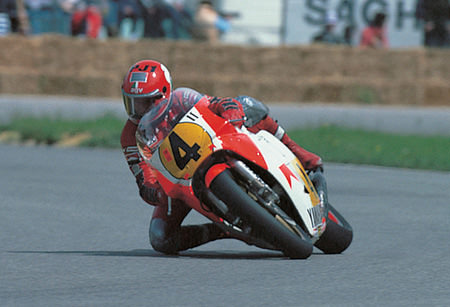
Riding the radically improved YZR500 (0W70) in 1983, “King” Kenny Roberts staged a historic season-long title showdown with Freddie Spencer
Direct Application of YZR Knowhow
“At that time, we tried anything and everything with race machines if we thought it might give us an advantage...,” said Racer Group engineer Teruo Abe, who was suddenly assigned to serve as Project Leader for developing the TZR250. Obviously, this statement showed confidence in his knowledge of the development of the YZR500 until that time.
“For example, take the case of moving the YZR500’s engine position by 20 or 30 mm. This wouldn’t have much effect on the machine’s front-rear weight distribution or other qualities.
But when you then actually tried riding it, you would discover big differences. That’s the kind of severity you have when working with a racer.” Needless to say, Abe spoke from his experience of having worked to solve problems like front wheel chatter
(high-frequency front wheel vibration in a corner) with the YZR500 in its period with an in-line 4-cylinder engine.
“Having this kind of knowhow under our belts, we were able to develop the TZR250 without making many big changes right from the design stage,” continued Abe. “In the handling as well, there were no problems using things as they were, such as the alignment. We also had knowhow regarding rigidity balance from our experience developing the Deltabox frame for the 0W70. We were able to scale down things like that from the 500cc to the 250cc machine, so it had more than enough performance potential for riding on public roads as a production model.”
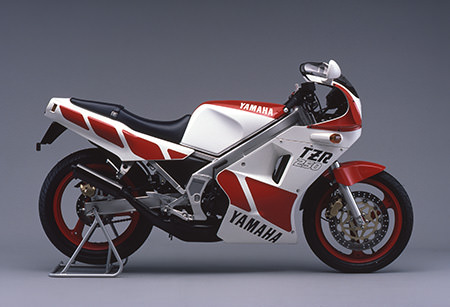
TZR250
Developed concurrently with the 1986 TZ250 production racer, simply outfitting this model with kit parts gave it the performance potential to compete in “TT-F3” modified production model races (Released in 1985)
“Regarding the tires as well, one time we tried using a small-diameter 16-inch front tire on the YZR500. The aim to increase lightness and agility when leaning into a corner in that way was understandable. But it turned out that in the high-speed corners, there was a moment of time lag before you could feel the front end grip the road and that caused understeer. Yamaha riders dislike that kind of unstable tendency. So we ended up staying with the 17-inch wheel for the YZR500. As a result, with the TZR, we began by developing a production-use 17-inch tire from the beginning,” noted Abe.
“The first consideration with handling should be making sure that you have a good feeling of stability. That makes it possible for riders to put their trust in the bike, and we believe that it’s only then that they can begin to ride aggressively. If riders have doubts about how the machine will react, they can’t ride with confidence,” concluded Abe.
This is a central principle of Yamaha Handling and it’s the same for the YZR500 as it is for a general road-going sports model. And, they believe that principle holds true for all characteristics of a bike’s performance.
Abe went on to say, “Although it may not be strictly in the area of ‘handling,’ this approach holds true for the brakes as well, doesn’t it? The TZR was fitted with 2-pot calipers and provided very strong braking performance. But, in addition to plenty of braking force, the brake has to have good controllability as well. If it’s hard to control, the rider won’t feel confident, no matter how much braking force it has.”
“In developing the suspension characteristics as well, we chose a lever ratio setting for the link that didn’t make it too progressive. That’s because if it’s too stiff in the compression stroke, it makes the machine difficult to ride. We made it as linear in feel as we could,” he added. All of these design directions came directly from the approach adopted on the YZR500 factory machine.
The Incredible TZR250: Exceptionally In Tune with the Rider
When I first rode the TZR250, I honestly felt that it was just like riding the YZR500 and it was an experience I’ll never forget.
It had a larger, more spacious feeling than conventional 250cc models and the sense of volume felt similar to a 500cc model. What made the ride so exciting was that the motion of the suspension and the feeling of the handling weren’t related to what the machine’s engine displacement was. Rather,
the impressive thing was how all aspects of the machine’s motion and its responsiveness were designed and fine-tuned to enable the rider to get used to the motion so quickly.
As for the engine character, it was quite powerful for that time, but what impressed me more than that was the great ridability in the mid-range. Of course, the feeling of stability from the chassis was so great it was hard to believe it was a 250cc machine, and the handling maintained a very neutral balance that gave the rider a very good feeling of assurance.
All this naturally made the bike very easy to get accustomed to, and you felt confident to ride it through turns at a sportier pace. At the time, the arrival of the RZ250 inspired a 2-stroke 250cc racer replica boom, which in its early stages saw the release of the Suzuki RG250Γ, the Honda NS250 and so on. These new models were all lightweight, compact and had handling considered sharp even for a 250cc class bike. In contrast to these machines which were clearly meant to appeal to young riders, the TZR250 also appealed to veteran riders thanks to its larger, more spacious package and high level of refinement.
“With a race machine, the starting assumption is that it’s going to be used at full throttle most of the time. But with a production model, every rider is going to apply throttle differently and ride differently, and that’s the area that we had the most difficulty with in developing the TZR250,” recalled Abe. The handling of the TZR250 quickly won the praise of more experienced riders. Its easy-to-ride character also made it popular among beginners and—as everyone knows—it went on to become a big hit. Most were thrilled by its handling which enabled them to control the machine so naturally that they felt they had suddenly become better riders. The TZR250 made it possible for them to really enjoy cornering in a way that they had been reluctant to try with other bikes. It was not long before you began to hear riders everywhere talking in general about the handling of “this bike” or “that bike.”
In World GP, the pinnacle of motorcycle road racing,
the development theme for the premier class 500cc machines was shifting to the question of how to give the riders the control they needed to compete in the increasingly intense power competition. This can be considered the first case where solving this challenging issue required not only specific knowhow in the area of handling but also a development philosophy.
In the realm of production models as well, the advances in technology led to the development of radial tires and liter-class big-bikes that required manufacturers to deal with the issues presented by the even higher levels of energy involved. That led to a development environment still dominated by a blind competition for ever-higher specs, and it was only after this that the concern for handling that made bikes easy to ride would follow and gradually become established.
In this sense, the significance of the TZR250 as a replica of the YZR500 went beyond merely copying the factory machine’s appearance. It established a true connection in performance and evolved even further based on that connection, making it a truly important and symbolic bike in that era of dramatic change in the motorcycle industry. We also must recognize that this was something that only Yamaha, with its great wealth of experience in the area of handling, could have achieved at the time.
However, with its Yamaha Handling reputation chiefly built on a concern for the feeling of machine stability, it was only just the beginning of a new realm of competition for Yamaha against its rivals that were still dedicated first and foremost to winning the battle for spec numbers. This was a competition that was far from over.
Especially in the area of big bikes, where the primary concern for the testing group working on production models was user benefits, their above-all dedication to handling would make the FZ and FZR Series stand out from the competitors’ big bikes in dramatic ways.
(Continues in Vol. 6)
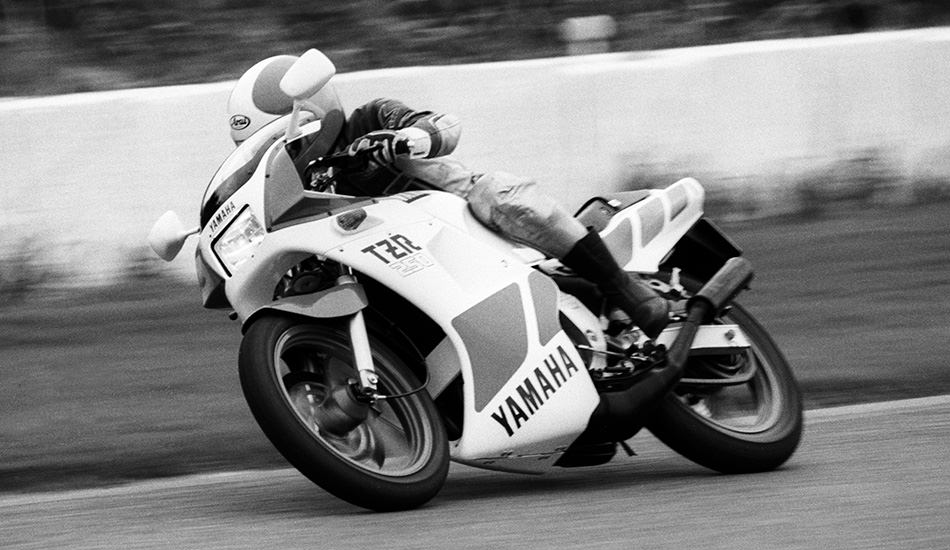
Ken Nemoto test-riding the TZR250. He stated that its ride character strongly resembled that of the YZR500 race machine (1981)



